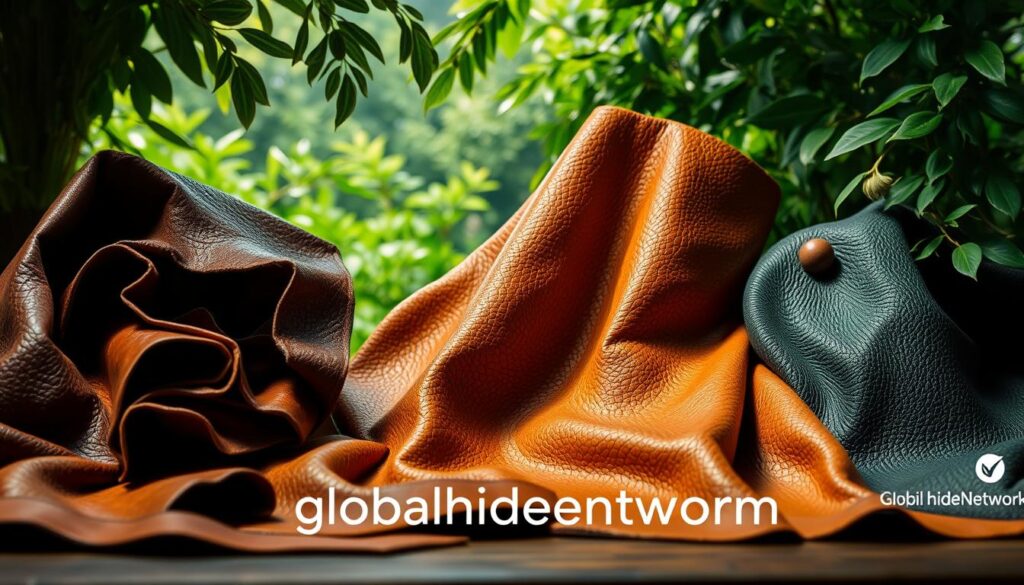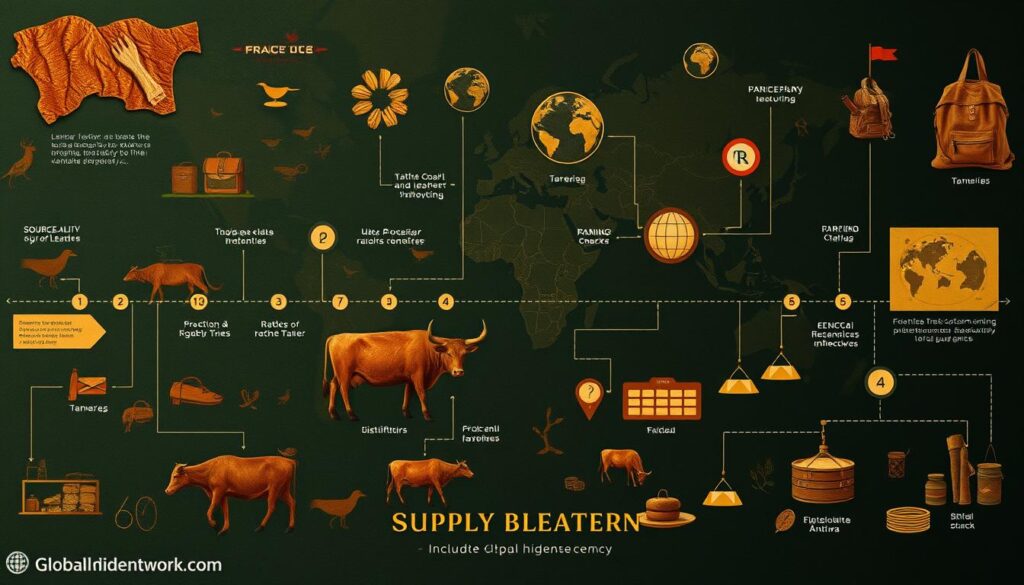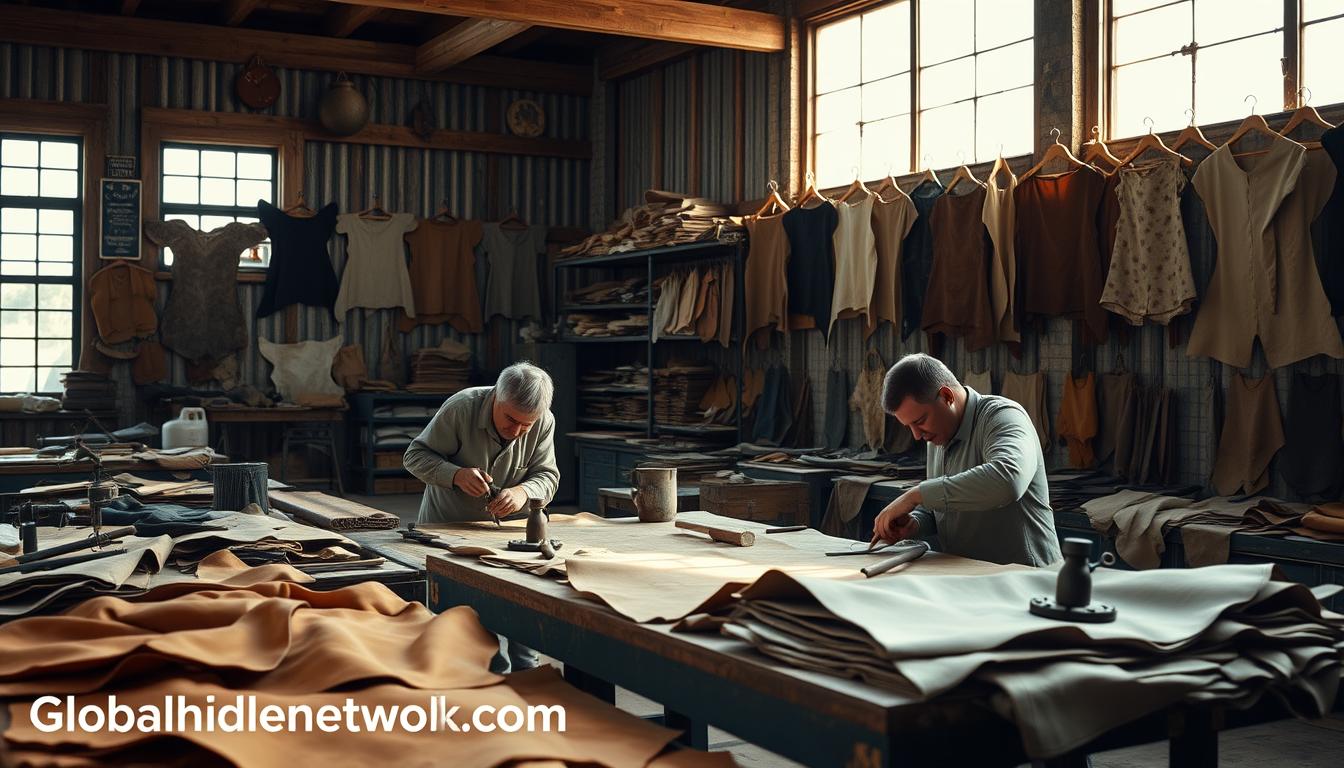I’ve seen a big problem in the leather world. Many brands find it hard to get good hides and be green at the same time. This is tough for makers and buyers alike. Without the right way to get hides, we might lose quality and hurt the planet. But, there’s hope! By following the best ways and teaming up with green tanneries, we can fix these issues.
Good sourcing rules are the answer. They make sure animals are treated right, workers are paid fairly, and the planet is protected. When brands follow these rules, they get more respect and attract people who care about the earth. It’s a win for everyone in the leather world.
Key Takeaways
- Sustainable leather sourcing emphasizes transparency and eco-friendly practices
- Ethical sourcing ensures humane animal treatment and fair labor conditions
- Eco-friendly tanning methods reduce environmental impact
- High-quality craftsmanship enhances product durability
- Traceability in the supply chain aids informed consumer choices
- Innovative technologies support efficient use of leather and reduce waste
Understanding the Importance of Responsible Leather Sourcing
I’ve seen a big change in the leather world. Brands and people are now focusing on getting leather the right way. This change is changing how we see our favorite leather items.
Growing Awareness Among Brands and Consumers
More brands are choosing to source leather responsibly. They know it’s key to their good name. People like me want to know where our leather comes from and how it’s made.
Impact on Brand Reputation and Consumer Choices
Brands that choose ethical leather are winning our hearts. I’m more likely to buy from companies that care about the planet. It’s not just about looking good – it’s about feeling good about what we buy.
Creating a Sustainable Future Through Collaboration
I’m excited to see brands and people working together for a better future. This teamwork is leading to new ideas in the leather world. We’re seeing better tanning methods and fair work practices. Now, knowing where our leather comes from is common.
- Only 15% of hides worldwide are suitable for full-grain leather
- High-quality leather products are durable, reducing environmental impact
- Leather is biodegradable when sourced responsibly
By supporting ethical leather, I’m helping make fashion better. It’s a small step, but it’s important.
Types of Leather: Choosing the Right Source

Choosing the right leather is key for quality and being green. It’s vital to know the different sources and their effects.
Full-grain leather is the best quality. It’s great for things like furniture and accessories. Top-grain leather is less durable but perfect for jackets and coats. Suede leather is soft and used in luxury items.
Animal welfare is important in leather production. Most leather comes from cows, sheep, and goats. Cowhide is strong and good for furniture. Goatskin is lighter and softer, perfect for gloves or shoes.
Here’s a breakdown of leather types and their uses:
- Full-grain: Furniture, accessories, dress belts
- Top-grain: Clothing, jackets, coats
- Suede: Luxury accessories, fashionable garments
- Genuine: Wallets, belts, boots, car interiors
- Bonded: Upholstery, accessories (less durable)
Tanning methods also matter for leather quality and the environment. Chrome tanning is common but harmful. Vegetable tanning is eco-friendly, making leather firm and biodegradable. Chrome-free tanning makes softer leather.
For sustainable choices, deadstock leather is a good option. It’s for unique, limited products and saves money for businesses.
Certifications and Standards in Leather Sourcing
Certifications are key in promoting green tanneries and eco-friendly leather. They help us make better choices and encourage brands to act responsibly.
Leather Working Group (LWG) Certification
The Leather Working Group is a leader in checking if leather is made in an eco-friendly way. They have a list of green tanneries online.
Cradle To Cradle Products Innovation Institute
This group focuses on making leather products that can be used over and over. It’s a big step towards making leather production more eco-friendly.
ToxFMD Screened Chemistry
ToxFMD checks if the chemicals used in making leather are safe. It’s important for making sure tanneries are truly green.
Global Organic Textile Standard
GOTS is mainly for textiles but also covers leather. It has strict rules for the environment and people, helping leather production be greener.
| Certification | Focus Area | Impact on Sustainability |
|---|---|---|
| LWG | Environmental compliance | Promotes sustainable tannery practices |
| Cradle To Cradle | Circular economy | Encourages multi-lifecycle product design |
| ToxFMD | Chemical safety | Ensures safer leather processing |
| GOTS | Environmental and social criteria | Supports overall eco-friendly production |
By picking products with these certifications, I help brands that care about the planet. It’s a small way to make fashion more responsible.
Traceability in the Leather Supply Chain
I’ve seen a big change in the leather world: more focus on tracing where things come from. Brands and stores want to show where their leather comes from. This is because of rules about being responsible and what people want to buy.
Tracking the supply chain means getting info about who makes the leather. This includes names, addresses, and how to reach them. Tools like SourceMap, SupplyShift, and ChainPoint help with this.

Now, tracing leather is getting better. It lets us track each piece of leather. This is done with DNA, barcodes, and laser marks.
Sadesa is a leader in this area. They’re known for being great at tracing leather among over 300 users. They make high-quality leather in South America and Asia for many industries.
| Traceability Method | Examples |
|---|---|
| In-product tracers | DNA molecules (Haelixa, AppliedDNA, Identigen) |
| On-product tracers | Barcodes (GS1), Physical stamping (Gibson Stamp), Laser marking (CTC CO2 Laser System) |
Europe is planning to make digital tags for clothes and textiles by 2027. This will help make the leather industry even more open and responsible.
Alternative Materials: Pros and Cons
I’ve been looking into different materials instead of traditional leather. It’s a big field with many choices. Each one has good points and not-so-good points.
Recycled Leather Options
Recycled leather is becoming more popular. It’s made from old leather scraps. This helps save resources and cuts down on waste.
But, the quality can change a lot. Also, making it still uses a lot of energy.
Vegan Leather: Marketing vs. Reality
Vegan leather is seen as eco-friendly. But, it’s not that simple. Most vegan leathers are made from plastics like polyurethane.
They might use less carbon than real leather. But, they can’t break down naturally.
Durability and Environmental Impact Considerations
Real leather lasts longer and can break down naturally. This might make it a better choice over time. Vegan leather, though, is getting better.
Newer vegan leathers are made from plants like pineapple and mushrooms. They look promising but cost more.
| Material | Cost (per sq ft) | Biodegradable | Carbon Emissions (kg/sq m) |
|---|---|---|---|
| Traditional Leather | $7.50 | Yes | 17.0 |
| Vegan Leather (PU) | $5.00 | No | 15.8 |
| Pineapple Leather | $3.25 | Partially | Data not available |
| Mushroom Leather | $25.00 | Yes | Data not available |
Deciding between these options means looking at durability, cost, and how they affect the planet. As tanneries get better at making sustainable products, we’ll see even more choices.
Sustainable Tanning Methods
I’ve found that making leather in a green way is changing the game. Eco-friendly tanning is becoming more popular. It cuts down on harm to the environment and supports fair practices.
Chrome-Free Tanning Techniques
Chrome-free tanning is a big step forward. It gets rid of harmful chemicals, making leather safer for everyone. This method uses less water and energy, which means less harm to our planet.
Vegetable-Tanned Leathers
Vegetable-tanned leathers are a greener choice. This old method uses plant tannins, making leather strong and looking good as it ages. It’s also free from bad chemicals, which is better for us and the Earth.
Innovative Eco-Friendly Tanning Agents
New tanning agents are coming out, like Zeology Leather. It uses zeolites, making leather that can break down naturally. These new products don’t have chrome, aldehyde, or heavy metals. They’re helping the leather industry become truly green.
| Tanning Method | Environmental Impact | Durability | Chemical Use |
|---|---|---|---|
| Chromium-free | Low | High | Minimal |
| Vegetable-tanned | Very Low | Very High | Natural |
| Zeology | Lowest | High | None |
Sustainable tanning is changing how we make leather. It cuts down on waste, saves resources, and makes products that last a long time. By picking these green options, we help make fashion more responsible and a cleaner world.
Ethical Considerations in Leather Production
Ethical leather making is more than just quality. It’s about treating animals right and workers fairly. The leather world struggles to mix sustainability with ethics.
Animal care is a big deal. Ethical makers make sure animals are treated well. They give them good food, homes, and care. It’s about the whole journey, not just the end product.
Worker rights are also crucial. Fair pay and safe places to work are key. Many companies focus on fair labor now, making the leather market more just.
Looking at the environment is another big issue. Using green tanning and cutting down waste is important. Some makers use vegetable tanning or chrome-free methods to lessen harm to the planet.
| Ethical Consideration | Impact | Industry Response |
|---|---|---|
| Animal Welfare | Improved living conditions for animals | Implementation of welfare standards |
| Worker Rights | Fair wages and safer work environments | Adoption of fair labor practices |
| Environmental Impact | Reduced pollution and resource use | Eco-friendly tanning methods |
Being open is vital in ethical leather making. Brands are now sharing how they make and source leather. This helps build trust and lets buyers make better choices.
Transparency and Accountability in Leather Sourcing
The leather industry is changing fast. It’s moving towards being more open and responsible. Groups like the Leather Working Group (LWG) and Sustainable Leather Foundation (SLF) are helping. They offer audits and standards for tracing where leather comes from.
Importance of Supply Chain Visibility
Knowing where leather comes from is very important. Timberland has made its leather supply chain fully traceable. This ensures the leather is of high quality and made in an eco-friendly way.
Thanks to this, water use in leather making has dropped by 35% in 25 years. This shows how important good practices are.
Building Trust with Consumers
Being open helps build trust with customers. Mulberry, for example, has shared its plans to use more sustainable leather. This lets buyers know their money is going towards good causes.
Leather items are also very durable. They can last for many years, which is good for the planet.
Tools for Tracking Leather Origins
The Leather Impact Accelerator was launched in 2021 and updated in 2023. It’s a tool for tracking where leather comes from. Farms and production facilities must meet certain standards.
Third-party verifiers check these standards. This makes sure the system is trustworthy. The program encourages brands to use approved suppliers and map their supply chains. This makes the leather industry more open and responsible.
